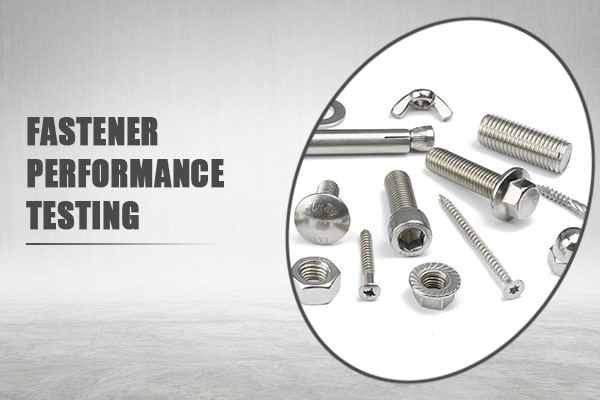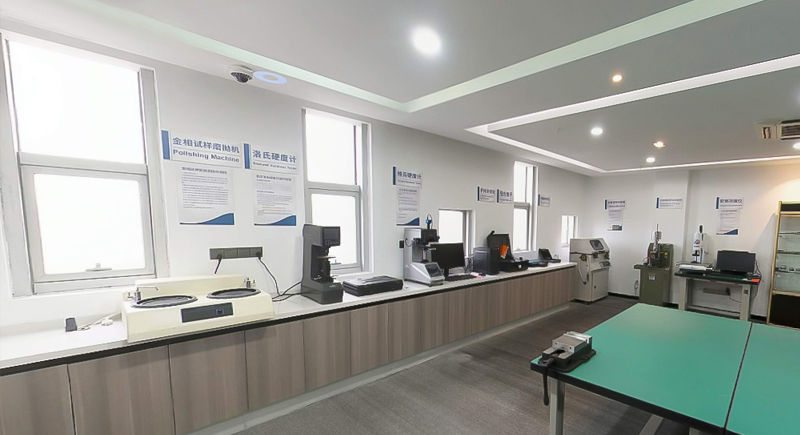VIDEO & CENTER

Fasteners are the general term for a class of mechanical parts used when two or more parts or components are tightly connected into a whole, which is currently a very widely used class of mechanical parts, known as the salt of industry. Fastener connection is a detachable connection, with good mechanical performance, strong bearing capacity, fatigue resistance, convenient disassembly, simple structure, low cost, is widely used in construction machinery, construction engineering, rail transit, electric power, aerospace and other industries, a computer host fasteners are not less than 25, a car engine fasteners have more than 200. There are more than 1,000 fasteners on a set of wind turbines, more than 2,000 fasteners on a subway car, and as many as 3 million various types of fasteners on a medium-sized aircraft. The key parts of many devices are connected by fasteners, so the reliability and safety of fasteners are very important.
Fasteners are characterized by a wide variety of specifications, different performance uses, and a high degree of standardization, serialization, and universality, usually known as "standard parts". There are many types of fasteners, according to their characteristics are mainly divided into: bolts, screws, studs, nuts, tapping screws, wood screws, pins, washers, retainers, rivets, assemblies and connecting pairs.

Fasteners are an important basis for the development and operation of major technical equipment, which directly determines the performance, level, quality and reliability of the equipment. Fastener testing technology is an important basis for ensuring the high-quality development of the core components and their supporting host industry, and the key to improving the level of product quality assurance. In order to ensure that the performance indicators of fasteners meet the standard requirements, it is necessary to test the performance of fasteners in the research and development stage, the manufacturing stage, the shipping stage and the use process. Fasteners usually require the following tests:
First, torque - clamping force test
The function of threaded fasteners is to generate the corresponding pre-tightening force on the bolt or screw by applying a certain torque to ensure that the connection is firmly connected together without loosening, and can be disassembled for easy maintenance. The size of the preload is an important factor to ensure the quality of the connection, and the main factor affecting the preload is the friction coefficient of the fastener itself in addition to the tools and tightening methods used. The torque-clamping force test is a comprehensive performance test for the fastener connection pair. The test is carried out on the dust friction coefficient tester. During the test, the fastening torque is applied smoothly to the bolt-nut connection pair or the screw-nut connection pair to generate the clamping force and measure its fastening characteristics. Including total friction coefficient, thread friction coefficient, bearing surface friction coefficient, yield clamping force, yield tightening torque, torque coefficient and a series of parameters. Commonly used testing standards are :GB/T16823.3-2010, GB/T1231-2006 and so on.
- Transverse vibration test
The transverse vibration test of fasteners is mainly to determine the self-locking performance of fastener connection under a certain frequency and amplitude of the transverse dynamic load (anti-loosening performance), which is widely used in the anti-loosening quantification of automotive fasteners, aviation fasteners, wind power fasteners, railway fasteners and other fasteners. The test is carried out on the fastener transverse vibration test machine, and the fastener under test is tightened on the test device to generate a fixed clamping force. With the aid of the testing machine, the alternating transverse displacement between the two metal plates being tightened loosens the connection, resulting in a reduced or even complete clamping force. The instantaneous value of clamping force can be recorded continuously, and the anti-loosening performance of fasteners can be determined according to the analysis and comparison of recorded data. During the test, the slower the clamping force decreases, the better the anti-loosening performance; On the contrary, the faster the clamping force decreases, the worse the anti-loosening performance. The commonly used test standard is GB/T 10431-2008.
- Measurement of size and geometric accuracy
The size and geometric accuracy measurement of fasteners is mainly checked according to the relevant national standards or technical requirements (agreements, specifications and drawing requirements, etc.). Commonly used testing standards are: JB/T9151.1 to JB/T9151.7 series standards, GB/T 28703-2012, GB/T 3103.1-2002, GB/T3177-2009, etc. Commonly used testing instruments are: coordinate, image measuring instrument, thread micrometer, thread ring gauge, vernier caliper, outer diameter micrometer and so on. The parameters tested vary with the fastener product, and the parameters usually tested for bolts are: large diameter, middle diameter and small diameter of internal and external threads, nominal length, thread length, opposite side width, diagonal width, head height, head diameter, head Angle half and so on.
- Finished wedge load test
The wedge load test of the finished fastener is mainly to determine the tensile strength of the bolt and the finished screw and the fastness of the joint between the head and the rod part or the threaded part. Commonly used testing standards are: GB/T3098.1-2010, GB/T 3098.23-2020, NB/T 31082-2016, GB/T 1228-2006, GB/T 1231-2006, GB/T 3632-2008, etc., mainly through the tensile testing machine for testing, Special test fixtures and wedge pads of different angles are required. The wedge load test is to place the special wedge pad fixture under the sample head, and apply axial load to the sample on the tension test machine. The tension test should continue until the sample breaks, and the fracture should occur in the rod part or the length of the thread that is not screwed, and should not occur at the junction of the head and the head rod.
- Tensile test
Tensile test refers to the test method to determine the properties of materials under axial tensile loads. The strength and plasticity data obtained by tensile test are of great reference value for fastener design, material selection and product quality control. Fasteners need to do tensile test products are mainly bolts, screws and studs, bolts, screws and studs tensile test is divided into finished product tensile test, mechanical processing specimen tensile test. Commonly used testing standards are: GB/T 228.1-2021, GB/T 3098.1-2010, GB/T 3098.23-2020, NB/T 31082-2016, GB/T 1228-2006, GB/T 1231-2006, GB/T 3632-2008, etc., If it is tested by universal material testing machine. There are several types of tensile tests for bolts, screws and studs: tensile tests to determine tensile strength, tensile tests to determine elongation and 0.0048d non-proportional extension stress, tensile tests for bolts and screws with weak heads, tensile tests for waist bar fasteners, etc. The tensile test of mechanical processing specimens requires standard samples to be prepared according to the standard, and the minimum tensile strength, lower yield strength or 0.2% non-proportional extension stress RP0.2, elongation after fracture and section shrinkage are measured.
- Guaranteed load test of finished product
Guaranteed load refers to the limit load that the thread product can withstand without obvious plastic deformation, and the product of this value is determined by the product of the thread stress cross-sectional area and guaranteed stress. Fasteners to do the finished product load test products are: bolts, screws and nuts. The guaranteed load test method for bolts and screws is to perform a specified guaranteed load test on the product and measure the amount of permanent elongation generated by the guaranteed load. The commonly used testing standards for bolt and screw J guarantee load test are: GB/T 3098.1-2010, GB/T 3098.23-2020, DL/T 1236-2021, NB/T 31082-2016, GB/T 1231-2006, GB/T 3632-2008, etc. The commonly used test standards for nut guarantee load test are: GB/T 3098.2-2015, GB/T 3098.9-2020, DL/T 1236-2021. The load test is mainly carried out by the universal material testing machine, and is equipped with the fixture and length measuring device required by the test. The bolt and screw J ensure that the permanent elongation before and after the load test cannot exceed +12.5um.
- Failure torque test
For bolts and screws whose thread specifications are less than M3, it is impossible to accurately determine the breaking load and guarantee load due to the influence of the accuracy of the thread and the accuracy of the test device, and the minimum tensile load and guarantee load of bolts and screws are not specified in the standard. Bolts and screws larger than M3 to M10 are too short in length to be subjected to tensile tests. GB/T 3098.13-1996 standard specifies the minimum failure torque of M1-M10 bolts and screws, and the failure torque test can be carried out. The failure torque test is to clamp the bolt and screw sample in the test device, apply the torque continuously and steadily, and measure the failure torque value.
- Hardness test
Hardness is an important technical index of material hardness, is the ability to resist other objects pressed into its surface, is the ability of the metal surface to resist deformation and damage. Hardness test is the most commonly tested item for fasteners, for fasteners that cannot be stretched, hardness test can be carried out to verify the heat treatment process and ensure that the hardness does not exceed the hardness range allowed by the fastener standard. If the hardness of the fastener product exceeds the maximum allowable level, the fastener will be embrittlement during use. The conventional hardness check is usually carried out on a suitable surface or cross section through a specific area of the fastener thread, and the commonly measured hardness is Vickers hardness, Brinell hardness, Rockwell hardness. Hardness test commonly used testing standards are: GB/T 4340.1-2009, GB/T231.1-2018, GB/T 230.1-2018, GB/T 3098.1-2010, GB/T 3098.2-2015, GB/T 3098.23-2020, DL/T 1236-2021, GB/T 121-1986, NB/T 31082-2016, GB/T 1231-2006, GB/T 3632-2008, etc. The surface of the test specimen for surface hardness test should be flat and smooth, the test surface should be free of oxides and foreign dirt, and it should not be greasy.
- Impact test
Impact test is to place the notch sample with specified geometry between the two supports of the impact testing machine, place the notch on the back of the impact surface, and use a pendulum to strike the sample once to break the sample, measure the absorbed energy of the sample, and verify the toughness of the material. Fasteners need to do the finished product to ensure the load test products are: bolts, screws and studs, impact tests are usually under low temperature conditions, generally at -20°C. The impact sample shall be made into a standard sample, and the notch of the sample shall be V-shaped or U-shaped according to the provisions of the standard. Commonly used test standards for impact tests are: GB/T 229-2020, GB/T3098.1-2010, GB/T 3098.23-2020, DL/T 1236-2021, NB/T 31082-2016, GB/T 1231-2006, GB/T 3632-2008, etc.
- Metallographic analysis
Fastener products usually need to carry out metallographic analysis of the test items are: decarbonization test and surface defects.
The decarburization test is mainly to determine the surface decarburization of fasteners after quenching and tempering and the depth of the decarburization layer. The depth of the full decarburization layer and the height of the decarburization layer at the end of the thread can be determined by the face or hardness method and the metallographic method. The metallographic specimen shall be made from the fastener _ after the coating or other coating has been removed after the completion of the entire heat treatment process. It is usually cut from the longitudinal section that passes through the specific area of the fastener thread, and then the specimen is made into a metallographic specimen by using a Mosaic machine and a grinding machine and observed by a metallographic microscope. Commonly used testing standards are GB/T 224-2019, GB/T 3098.1-2010, GB/T 3098.23-2020, DL/T 1236-2021, NB/T 31082-2016, GB/T 1231-2006, GB/T 3632-2008 and so on.
The surface defect test can be conducted in two ways: non-destructive inspection and destructive inspection. The non-destructive inspection is mainly visual inspection to check whether the appearance of the product has obvious defects specified in the standard.
Destructive inspection is the metallographic method, which requires the use of a Mosaic machine and a grinding machine to make a metallographic sample and observe it under a metallographic microscope. Commonly used testing standards are GB/T 5779.1-2000, GB/T5779.2-2000, GB/T 5779.3-2000.
- Chemical composition analysis
The different types and ratios of chemical elements in fastener materials directly determine whether the material can achieve the required performance through subsequent treatment, and improper material selection will lead to premature failure of fasteners
And major accidents can occur, so chemical composition analysis is particularly important. Chemical composition analysis is mainly to determine the content of various chemical elements in fastener materials, the most commonly detected elements are: carbon C, silicon Si, manganese Mn, phosphorus P, sulfur S, chromium Cr, nickel Ni, copper C, etc. Commonly used analytical instruments have direct reading spectrometer, carbon and sulfur analyzer, inductively coupled plasma emission spectrometer (ICP), etc. Commonly used detection standards are: GB/T 4336-2016, GB/T 11170-2008, GB/T20123-2006, GB/T 20125-2006, etc.
- Corrosion test
Corrosion test is the use of corrosion test box to simulate the actual corrosion environment of fastener products, determine the corrosion performance of the product, verify the corrosion resistance of the product, evaluate the service life of the product, and the length of its resistance time determines the corrosion resistance. Common corrosion tests include neutral salt spray test, acetic acid salt spray test and copper accelerated zate salt spray test, and the commonly used test standard is GB/T 10125-2021.














